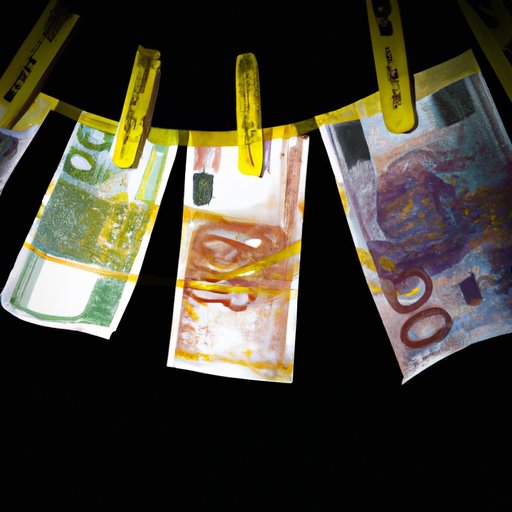
I. Introduction
Money laundering is a phrase that has become more common in recent years. It is a crime that affects people globally. The more one understands about the process of money laundering and how it affects the world economy, the better equipped they are to protect themselves.
II. Money Laundering 101: Understanding the Tactics and Implications Behind the Illegal Scheme
Money laundering is the process of disguising the proceeds of illegal activities as legitimate funds. Illegal activities that generate large amounts of cash – such as drug trafficking, fraud, and human trafficking – are the most common sources of laundered funds. The primary goal of money laundering is to make the proceeds of illegal activity appear as though they were earned through legitimate business transactions.
Money launderers often use several methods to keep the source of their funds untraceable. The most common method is called “smurfing,” where the launderer will break up large sums of money into smaller amounts and spread the funds across multiple accounts in different countries. Wire transfers are also a common way of transferring funds from one country to another with the intent of disguising the origins of the funds.
Money laundering is a crime because it facilitates illegal activity and undermines the global financial system by increasing the volume of criminal funds that move through the economy. It has implications on the economic stability and growth of nations.
III. From Tax Evasion to Terrorism Funding: Why Money Laundering is a Growing Global Concern
Money laundering is a growing global concern that encompasses many different types of crimes. Tax evasion is one common way that criminals engage in money laundering. Other crimes that are frequently associated with money laundering include drug trafficking, human trafficking, arms trafficking, and terrorism funding.
Over the years, numerous high-profile cases involving money laundering have come to light. For example, the Panama Papers, which were leaked in 2016, exposed a global network of companies used by wealthy individuals to conceal assets and avoid taxes. Another example is the HSBC scandal, in which the bank was fined $1.92 billion for allowing drug cartels to launder money through its system.
Money laundering affects the global economy by creating an environment where criminals can engage in transactions with less risk of being caught. This can increase the overall cost of doing business and weaken the stability of financial institutions.
IV. The Art of Concealing Illicit Funds: A Look into the Techniques Used in Money Laundering
There is no single method that money launderers use to conceal illicit funds. Instead, they employ a wide range of techniques that are designed to make it difficult to trace the source of the original funds. One of the primary ways criminals conceal funds is by using shell companies to move money and hide the true ownership of assets. Other techniques include the use of offshore accounts, wire transfers, and the purchase of high-value assets such as real estate or art.
Money launderers also often use a technique called “layering,” where they will move funds across multiple accounts and/or countries in an attempt to make it increasingly difficult to track the source of the funds. Once the funds have been successfully laundered, they can be reintroduced into the economy and used for legitimate purposes.
There are many examples of how these techniques have been used successfully in the past. For instance, a drug cartel in Mexico used a horse-breeding business to launder its profits. Another scheme involved the use of a casino in Las Vegas to launder money.
V. The Role of Banks and Financial Institutions in Preventing Money Laundering: A Comprehensive Guide
Banks and financial institutions play a critical role in preventing money laundering. They are part of a global framework known as Anti-Money Laundering (AML) regulations, which is designed to prevent criminals from using the financial system to launder money. Banks and financial institutions are responsible for following these regulations and implementing the necessary measures to detect and prevent money laundering.
One measure banks and financial institutions use to prevent money laundering is the Know Your Customer (KYC) process. This process involves gathering customer information and verifying their identities to ensure that they are legitimate and not involved in any illicit activities.
Other measures include transaction monitoring, which involves monitoring account activity for suspicious transactions and reporting any suspicious activity to regulatory authorities such as the Financial Crimes Enforcement Network (FinCEN) in the United States.
VI. What Happens After the Crime: How Government Agencies Track and Prosecute Money Laundering Offenders
Once money laundering is discovered, government agencies are responsible for tracking and prosecuting offenders. In the United States, this responsibility falls to the Department of Justice and the Internal Revenue Service.
Investigations into money laundering can be complex and time-consuming. They often involve working with other countries and regulatory bodies to track down the source of the funds and determine how the laundering was carried out. If the launderer is successfully prosecuted, they could face significant penalties, including jail time and fines.
VII. Conclusion
Money laundering is a global problem that affects everyone. It is important to understand the tactics and techniques used by money launderers to prevent the financial system from being used to facilitate criminal activity. Banks and financial institutions, along with government agencies, play a critical role in fighting money laundering. By working together, we can create a safer and more secure financial system for all to use.





